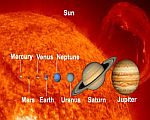- Home
- Really Weird Stuff
- The Matrix
Could The Matrix Be Real? How could it be tested?
Most of you reading this will probably have seen the movie "The Matrix", but, just in case you haven't, here's the premise:
All of the "reality" that we humans see around us isn't real at all; it's a computer simulation generated by a race of machines (which were originally created by humans, but evolved to be conscious and have their own intelligence). In the real world, humans are held in pods, where their brains are wired up to this program. It is intended to keep them under control while the machines harvest their body heat and bio-electricity as fuel.
All very well depicted as fiction, but could the movie's premise be true? Could we all be actually living in a computerized simulation of reality? We would need a way to test it, but, if the simulation is indistinguishable from reality, is there any way to do this? Amazingly, there is!
The Large Scale View
Any computer simulation would have to consist of a three-dimensional lattice advancing in time onto which the physical laws of our Universe would be superimposed. This would imply a limit to the energy that particles travelling about the Universe can have, because nothing could be smaller than the lattice itself. In other words, there must be some sort of "cut-off" point. Well, read on...
The GZK Cut-off
The Greisen-Zatsepin-Kuzmin cut-off (thankfully often abbreviated as in the heading) is an upper limit to the possible energy of cosmic rays travelling over great distances. As these particles' energy increases, they probe ever smaller regions of space. For there to be an upper limit to the energy, there must, therefore, be a lower limit to the region of space. This could be the limit imposed by this theoretical "lattice".
The clincher, though, would be if such a lattice also affected the cosmic rays in another way. It is thought that, instead of travelling randomly in all directions, the cosmic rays would tend to travel along the axes of the lattice. If they were found to do this, it would conclusively prove its presence and, therefore, that the Universe is a computer simulation.
Research is actually underway into this, most notably by Silas Beane, at the University of Bonn, in Germany.
The Small Scale View
For this section, we need to consider the pronouncements of NASA scientist, Rich Terrile. He maintains that, at phenomenally small scales, the Universe is "pixelated", this is, you cannot go on dividing particles forever - at some point, there is a fundamental unit, from which the fabric of the Universe is made.
According to something called Moore's Law, computational power tends to double every two years, so computers of the future will be extremely powerful. But, will they have enough programming capability to create a simulated Universe? For this, Terrile cites a branch of science known as quantum chromodynamics (QCD). This discipline postulates (according to Terrile) that a particle does not have a definite state unless it is actually being observed. This seems to suggest that particles are only there when we need to see them - a way, in a possible simulated Universe, of conserving processing power.
Brain-Computer Interface
So far, we've only discussed the possibility of the Universe being a simulation. But, what about the further premise of The Matrix - that we humans, whilst plugged into the simulation, actually exist as real people in the real world?
Neo, Morpheus and the others were able to use a brain-computer interface to plug into the Matrix. The program then sent messages to their brains, affecting all five senses, allowing them to act within the simulation. However, also in the Matrix are sentient computer programs (the "Agents"), that cannot exist in the real world.
The Matrix thus represents a type of "intermingled" simulation, containing both avatars of real people and virtual people.
If the Universe is a simulation, the likelyhood of this actually being the case is remote. We are more likely to be virtual entities created along with the simulation.
Why Create a Matrix in the First Place?
Consideration of this question takes us a little way into the realms of philosophy.
It has been proposed that, assuming the human race (or other civilization, come to that) can become sufficiently technologically advanced, without destroying itself, to create a Matrix, then one will be created. It could be that, for example, in the real world, Hitler was victorious in the Second World War and the programmers wanted to see how the world turned out if he wasn't. Our Universe would be the resultant simulation.
This existing simulation would then eventually become technologically advanced itself and possibly end up creating a Matrix-within-a-Matrix. This could go on, until the amount of virtual people far outnumbered that of real people. Thus, it is far more probable that we are virtual people living in a Matrix.
Implications
The fact that a possible simulation is indistinguishable from reality is really the bottom line. We might as well be living in reality, if it's no different.
The only trouble is, if these theoretical programmers decide they've had enough of our particular Matrix, they do, presumably, have at their disposal an "off" switch.









Facebook Comments
Have your say about what you just read! Leave me a comment in the box below.